HISTORY
AND ORIGIN
Elizabeth Emery
(Gyalwa Lhasa Apsos)Ó
The isolated
country of Tibet has produced several
breeds of dogs, of which only four are
known in the West. One of the most
popular is undoubtedly the Lhasa Apso, a
small, long-coated breed now found all
over the world.
The origin of the
breed is well hidden by the passage of
time and the lack of written history-some
fanciers claim that the breed was known
in 800BC, but evidence of this is slim.
The term
‘Apso’ seems to have been used
in Tibet to refer to a number of dogs-the
little book ‘A Brief Account of
Tibetan Dogs’ by the Apso Committee,
India, mentions large and small apsos,
and five classes of apso-two of which are
included in the mastiff breeds! However,
in the West the term usually refers only
to the Lhasa Apso.
The word
‘apso’ has been translated as
hairy one, goat like (from rapso),
covered with hair all over, and hairy
beard. All these suit the Lhasa, but
could equally refer to any coated dog. In
Tibet the breed was known as Apso Seng
Kyi-Bark Sentinel Dog.
The reference to a
lion is due to the breed’s supposed
resemblance to a lion, but it should be
remembered that the lion of the Tibetan
art and religion was not the gold African
lion, but the mythical white snow lion.
The name lion dog
may also be connected with Buddha’s
power over the lion, which could diminish
and ‘become like unto a
dog…’ (Dogs of China and Japan
in Art and Religion; V W Collier,
Heinemann, 1921). The Lhasa certainly
resembles the stylized lion appearing in
Tibetan art but was not considered sacred
in any way.
Lhasa is , of
course, the capital city of Tibet and
also its religious centre. As many of the
original dogs to leave Tibet came from
Lhasa, generally as gifts from the Dalai
Lama or monasteries, it was logical to
attach the name of the city when naming
the breed for Westerners.
Y Y Y
The Lhasa Apso has
a unique character, and this must be due
to the character of the Tibetan people.
They are said to be suspicious of
strangers – hardly surprising in
that harsh country, brave, cheerful,
strong and friendly once strangers have
proven themselves no threat. Most Lhasa
Apsos share these characteristics.
The villages and
monasteries were guarded from the outside
by large mastiffs, which were chained
along the walls; as an extra precaution
there were also 'alarm' dogs on the
inside which were adept at
differentiating between friend and
stranger, and which would sound the
alarm, presumably in case the sleeping
mastiffs did not wake up!
Exactly when the
first Lhasa Apsos were taken to England
is not certain; in Frances Sefton’s
book, ‘The Lhasa Apsos’, there
is reproduced a sketch by Beatrix Potter
showing a small, longhaired dog which
closely resembles an Apso. This sketch
was done in 1885. However, the first date
on record for the breed in England is
1901, when Miss Marjorie Wild received
her first Apso from the Honourable Mrs
McLaren Morrison, who had brought some
dogs back from Darjeeling.
At this time the
breed was known as the Lhasa Terrier and
was shown in two size classes- 10inch and
14inch. By 1908 the breed was increased
to the stage where they were issued
Challenge Certificates, but after World
War 1 numbers decreased drastically.
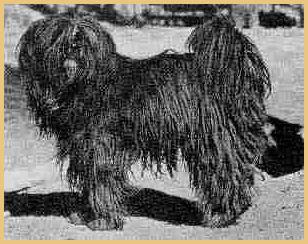
Apso
photographed in Tibet by Lt Col.Bailey
It was not until
1928 that the breed started the uphill
climb to popularity once again. This year
saw the return of Lieutenant Colonel and
Mrs Eric Bailey from India with five
descendants of their original stock
obtained in 1922 plus a male. These dogs
were Taktru, Droma, Tsitru, Pema, Litsi
and the male,Lhasa.
Several other
families brought back specimens of the
breed after their tours of duty in the
Asian countries, but little is known of
these.
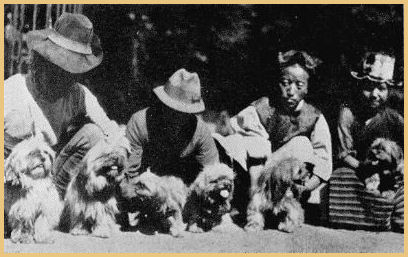
Six Lhasa
Apso imported from Tibet by the Baileys
in 1928; Lhasa(grey and white), and the
golds, Taktru,Droma,Tsitru, Pema and
Litsi (left to right)
Lhasas reappeared
in the show ring in 1929 at a
member’s show . In 1933 the first
class of them was held at WELKS . A dog
owned by Lady Freda Valentine , Changtru,
is said to have caused a sensation when
exhibited at this year’s shows.
In 1934 a Tibetan
Breeds Association was formed by Colonel
and Mrs Bailey, to further the progress
of the breed, and in the same year the
English Kennel Club approved the
breed’s standard . Miss Marjorie
Wild’s Satru , sired by Lhasa ex
Litsi , was one of the top winning dogs
of the 1930’s, and with his sister,
Sona, formed an unbeatable brace.
In 1930 Miss E M
Hutchins brought a male long coated dog
from China for his owners, Sir Douglas
and Lady Brownrigg. When the Brownriggs
returned from China themselves the
following year they brought a bitch , Shu
Ssa, and her litter. There were some
fundamental differences between these
dogs and those of the Baileys, but they
were shown together until 1934, when the
Brownrigg’s dogs were classified as
Shih Tzu.
With the coming of
World War II, many kennels were wiped
out, but a few managed to carry on . One
of these was Mrs Florence Dudman,
Ramblersholt, who lived in the country.
Miss Hervey-Cecil, Furzyhurst, also kept
a breeding nucleus throughout the war
years. A few isolated dogs also stayed
alive, but numbers were very few after
the war.
Following the war,
fanciers were keen to start up again, but
fresh blood was badly needed. In the
early fifties, a pair of Lhasa Apsos was
boarded with Miss Beryl Harding while
their owners, Colonel and Mrs Irwin, went
abroad. Miss Harding was allowed to breed
the pair, Dzongpen and Mingzong of
Madamswood, and keep all of the litter
except the pick. In this litter were two
bitches who were to have a great
influence on the breed-Brackenbury Lhotse
and Brackenbury Nuptse. Miss Harding kept
Brackenbury Lhotse, and from her descend
many of the present-day English lhasas.
Brackenbury Lhotse was mated to
Conquistador Kismet to produce
Brackenbury Min-nee, dam of the famous
English Champion Brackenbury Gunga Din of
Verles. Gunga Din’s sire was Jigmey
Tharkay of Rungit, A Tibetan import,
owned by Mrs Jill Henderson. He was
imported to improve the breed, which he
did, but unfortunately his owners left
England only three years later, taking
him with them. When Brackenbury Lhotse
was mated to Jigmey Tharkay, she produced
Eng Ch Brackenbury Chigi-Gyemo.
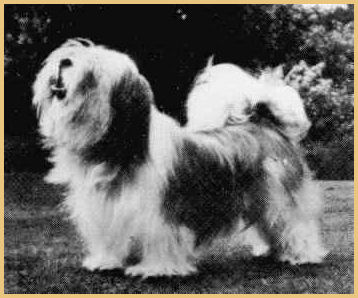
Eng Ch
Brackenbury Gunga Din of Verles.
In 1958 Mrs Daphne
Hesketh-Williams was given Ch Brackenbury
Gunga Din of Verles by her husband, and
this dog proved one of the most
influential sires ever on the English
scene. He not only sired a number of top
class Lhasas, but also won well in the
breed ring, being the first Lhasa to
become a champion after Challenge
Certificates were restored post-war. He
won the first five CC’s on offer in
1965, and won his sixth CC in 1967 at
Crufts, where he also won best of breed.
Among Gunga
Din’s progeny were Eng Ch Pontac
Adham Tarhib, Eng Ch Verles Yangdup of
Cheska, Eng Ch Cotsvale Brackenbury
Kan-ri, Eng Ch Verles Nying-Chem-Po, Eng
Ch Verles Keepa and Eng Ch Willowcroft
Kala from Hardacre. Gunga Din died in
1974, at nearly 16 years of age.
Brackenbury Nuptse
is of particular interest to Australian
fanciers as she was the dam of one of the
early imports, Aust Ch Ramblersholt Da
Norbu.
Y Y Y
Another
influential import to England was
Hamilton Dewatas, brought from the USA by
Mrs Bailey. He was the sire of
Brackenbury Kyi, Brackenbury Kalu of
Verles and Hardacre Ang Tharkay, among
others.
A bitch,
D’ang of Windermere, was imported
from Nepal and proved to be a useful
brood bitch. Around this time, Mrs
Frances Sefton obtained a bitch from
Sherpa Tensing, Jeri of Cheska. However,
imports were few and the quality of the
English Lhasas was due to careful
breeding by the enthusiasts.
Since those early
days the breed has grown remarkably in
England. By 1957 there were enough breed
fanciers to break away from the Tibetan
Breeds Association and form a breed club.
In 1969, the Lhasa Apso Club held its
first open show, judged by Monsieur Andre
Cluny. There were 91 entries and BIS was
Eng Ch Tayung of Coburg, bred by Mr and
Mrs J Mason and owned by Mrs F Sefton.
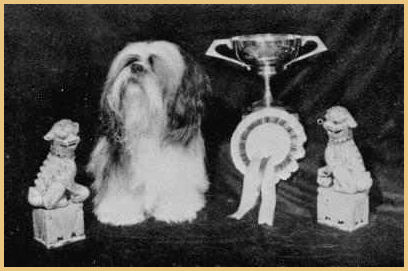
First
breed show in Britain, March 1969, was
won by Ch Tayung of Coburg.
Eng Ch Verles Tom
Tru was the first Apso in England to win
BIS at an all breeds show; he was
followed by his son Eng Ch Hardacre
Hitchcock who won many bests in show.
The first Apso to
take a championship show was Eng Ch
Cheska Alexander of Sternroc, who is also
the only Apso at the time to have won
best in group at Crufts (1974). His
daughter, Eng Ch Piplaurie Isa Silvergilt
of Hardacre was the second to win an all
breeds championship show.
Among the imports
that followed to England then were Saluq
Shaggy Wonder Ulan (Belgium), Saluq
Annapurna Quapito (France), Licos Ting La
of Cheska (USA), Am/Can Ch Hardacre
Kinderlands Bhu Sun (USA) and Eng Ch
Orlanes Intrepid (USA). The last
undoubtedly the most influential.
The first major
importers of Lhasa Apsos into the United
States were, of course, Mr and Mrs Suydam
Cutting. Between 1930 and 1940 the
Cuttings received three Lhasa Apsos from
the 13th Dalai
Lama. After the death of the Dalai Lama
the Regent sent them a pair of golden
Apsos and in 1950 the 14th
Dalai Lama sent the last pair.
The Cuttings dogs
were kept and bred at Hamilton Farms
under the care of James Anderson and Fred
Huyler. The Hamilton prefix quickly
became known and these dogs were a strong
force in the USA.
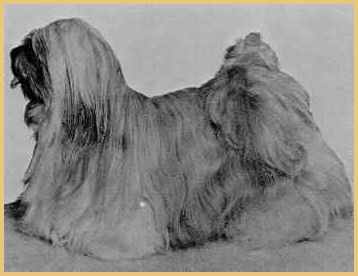
Am Ch
Hamilton Tatsienlu bred by the Cuttings:
Hamilton Yangchen x Hamilton Nova.
Other early
imports to the States included
Ramblersholt Le Pon, Ramblersholt Shahnaz
and Chumpa of Furzyhurst from England,
Ming Tai and Tai Ho from China and some
from Canada. Unfortunately some Shih Tzu
were also imported as Lhasa Apsos.
The breed was
recognised and its standard approved by
the American Kennel Club in 1935.
The breed gained
popularity far more quickly than in many
other countries; their exotic appearance
and lovable natures had great appeal, and
by 1977 there were 28 regional breed
clubs through the USA and Hawaii, while
annual registrations put them in the top
twenty breeds.
Among the greatest
American kennels were Karma (Mrs Dorothy
Cohen), Americal (Mrs Marie Stillman,
Licos (Mrs Grace Licos), Norbulingka (Mrs
Marcy) , Tabu (Norman and Carolyn
Herbel), Potala (Mrs Keke Blumberg),
Everglo(Mrs Gloria Fowler) and Orlane(Mrs
Joan Kendall Lohmann).
It was an American
Lhasa Apso which was the first anywhere
to win BIS , and in 1957 Am Ch Hamilton
Torma won the Twin Cities KC championship
show. Soon Apsos were no strangers to
best in group and best in show awards.
Interest in the
Lhasa Apso is widely spread throughout
the world and their popularity has grown
from these early days. The breed’s
easy adaption to a wide range of climates
is one of their great advantages as,
given reasonable care, they are equally
at home in hot, dry climates or those of
cold and snow.
Acknowledgement
to the excellent reference source; The
Lhasa Apso : F Sefton 1970
|